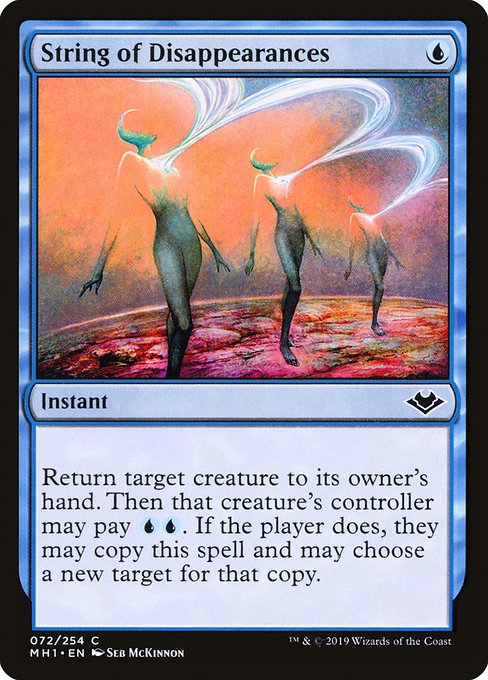
Image courtesy of Scryfall.com
Tempo, Tradeoffs, and Parallels: A Look at String of Disappearances in Modern Horizons
Blue in Magic: The Gathering has long thrived on tempo, control, and the pleasure of outthinking your opponent. String of Disappearances embodies that spirit in a tight, one-mana package. For a mere {U}, you bounce a creature back to its owner's hand, buying you untapped time and a potentially delicate edge on the exchange. But the card doesn’t stop there—the creature’s controller may pay {U}{U} to copy the spell and retarget the copy. It’s a small spell with a big dash of mind games, a microcosm of Blue’s capacity to impose friction on the battlefield. 🧙♂️🔥
First, let’s unpack the base power of this card. It’s an instant from Modern Horizons (MH1) with a modest mana cost of {U} and a single color identity: blue. The primary effect—return target creature to its owner’s hand—serves as a clean tempo play, slowing an aggressive start, triggering enter-the-battlefield or attack-phase decisions, and forcing your opponent to re-evaluate their plan with mana tapped in the wrong place. The true twist is the optional copy: if the affected creature’s controller pays {U}{U}, they copy the spell and may choose a new target for that copy. In other words, you’re gifting your opponent the chance to turn your tempo into a potential two-for-one if they’re willing to invest the mana. It’s a delightful interplay of choices that blue decks thrive on, turning small moments into long-term pressure. 🎲
In the grand scheme of blue’s toolkit, String of Disappearances slides into a familiar niche: cheap, instant speed bounce. However, its copy mechanic adds a rare wrinkle. Most one-mana bounce spells don’t offer this layer of interaction, which means String of Disappearances rewards players who read the table and anticipate what their opponent might do next. When you’re racing toward a board stall or a careful control win, you’ll appreciate how the spell buys time while introducing a plausible trap for the other side—a soft form of card advantage that compounds if the game spirals into a duel of wits. 💎
Where it sits among similar blue options
- Base tempo and speed: At its core, String of Disappearances is one of the cheapest ways to remove a creature on the stack, premiering in the early turns of a game. Its one-mana cost keeps you in the tempo driver’s seat while your other plans come online.
- Copy dynamics as a strategic lever: The copy mechanic introduces a dynamic rarely found in everyday bounce spells. If the opponent pays UU, you get a copy that you may retarget; if they don’t, you still succeeded in tempo play. This creates a micro-game about mana, timing, and willingness to engage in the spell’s risk-reward loop. ⚔️
- Format implications: In Modern, it’s a flexible tempo tool that plays nicely with counters, tap-outs, and blink effects. In Commander, the card gains extra texture as a political instrument—bounce an important creature, then watch the table’s response as everyone gauges whether to copy or retaliate. The shared blue ethos—control, sequencing, and board presence—gets a quirky, tangible twist here. 🧙♀️
- Value and collectability: Rarity-wise, String of Disappearances is a common. Its appeal isn’t in rare price pockets but in reliable gameplay and the fun of the copy interaction. Foil versions from MH1 show a little more sparkle, and the Seb McKinnon artwork elevates it as a talking point at the table. Price data on Scryfall indicates it remains a budget-friendly pick for players who want a polished blue spell with an intriguing decision point. 🎨
Art has a voice in MTG as loud as the rules text, and String of Disappearances speaks with a moody, blue-tinged elegance. Seb McKinnon’s illustration lends the card a storytelling edge—one that invites players to imagine a wisp of magic slipping through a lattice of spellwork and cunning. The beauty of the art pairs nicely with the card’s brisk, cerebral feel, making it a favorite among players who appreciate both flavor and function. The shared moments of realization—when you watch an opponent hesitate and then pay to copy—are part of what keeps blue so beloved among the community. 🎨
For players crafting a deck around this spell, a few practical notes help turn theory into reality. Build around the idea that the copy option invites interaction, not just a removal. Include other spells and creatures that benefit from opponents’ decision points—cards that reward you for your opponent’s willingness to invest mana or that thrive on you maintaining tempo while the table recalibrates. If you’re playing in a multiplayer setting, String of Disappearances can become a social catalyst at the table, turning a single bounce into a debate over who pays for the copy and what the next swing will be. 🧭
Intrigued by the mix of tempo, choice, and color-saturated flavor? The broader conversation around blue disruption and tempo across formats provides a richer context for how this spell stacks up in the long arc of the game’s history. It’s a perfect little spark card—modest in cost, bold in decision points, and quietly enduring in how it rewards smart play. 🔥
MagSafe Card Holder Phone Case (Polycarbonate, Glossy or Matte)More from our network
- https://crypto-acolytes.xyz/blog/post/solana-vs-sui-for-gaming-which-blockchain-delivers-better-performance/
- https://blog.digital-vault.xyz/blog/post/faint-blue-giant-informs-the-completeness-map-at-8000-light-years/
- https://transparent-paper.shop/blog/post/parallax-errors-propagate-distance-uncertainty-in-a-norma-blue-giant/
- https://blog.digital-vault.xyz/blog/post/tracing-origins-of-a-hot-giant-with-motion-vectors/
- https://crypto-acolytes.xyz/blog/post/crypto-and-international-law-navigating-global-challenges/